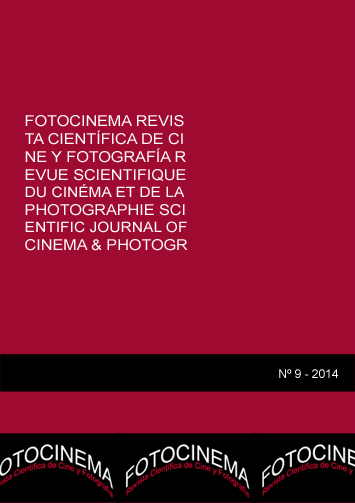Enrique Facio y el nacimiento de la fotografía de guerra en España
DOI:
https://doi.org/10.24310/Fotocinema.2014.v0i9.5972Abstract
El artículo aborda el nacimiento de la fotografía de guerra en España con la Guerra de África (1859-60). El fotógrafo pionero fue Enrique Facio, del que analizamos su obra. Empleamos las crónicas de guerra de Pedro Antonio de Alarcón, Diario de un testigo de la Guerra de África, que sirven para establecer la relación de las ilustraciones con las crónicas y porque los datos sirven para fijar algunas autorías de las fotografías. Además, se han utilizado archivos familiares, el Archivo General de Palacio (Madrid), el Archivo General Militar de Segovia y la Biblioteca Nacional. También se ha considerado a otros fotógrafos e ilustradores que retrataron la contienda bélica, como Carlos Iriarte, José Vallejo, José Requena y López, Lanos, Juan Del Peral, Dantez.Abstract:
This paper discusses the birth of war photography in Spain during the Hispano-Moroccan War (1859-60). The pioneer photographer was Enrique Facio, whose life and works are analyzed. The war chronicles of Pedro Antonio de Alarcón, Diario de un testigo de la Guerra de África, are used not only to establish the relation between the ilustrations and the chronicles, but also to determine the authorship of some of the presented photographs. Additionally, other sources such as family archives, the Palace General Archive (Madrid), the Military General Archive of Segovia and the National Library have been employed. Moreover, other photographers and ilustrators that portrayed the military conflict have been considered: Carlos Iriarte, José Vallejo, José Requena y López, Lanos, Juan Del Peral, Dantez.
Palabras clave: Fotografía de guerra; Enrique Facio; periodismo gráfico; vistas estereoscópicas; Guerra África.
Keywords: War photography; Enrique Facio; Graphic Journalism; Stereoscopic Views; Hispano-Moroccan War.
Downloads
Metrics
Publication Facts
Reviewer profiles N/A
Author statements
Indexed in
-
—
- Academic society
- N/A
- Publisher
- Universidad de Málaga
Downloads
Published
How to Cite
Issue
Section
License
All contents published in Fotocinema Revista científica de cine y fotografía are protected under the Creative Commons Attribution-NonCommercial-ShareAlike 4.0 International (CC BY-NC-SA 4.0) license. All about this license is available in the following link: <http://creativecommons.org/licenses/by-nc-sa/4.0>
Users can copy, use, redistribute, share and exhibit publicly as long as:
- The original source and authorship of the material are cited (Journal, Publisher and URL of the work).
- It is not used for comercial purposes.
- The existence of the license and its especifications are mentioned.
There are two sets of authors’ rights: moral and property rights. Moral rights are perpetual prerogatives, unrenounceable, not-transferable, unalienable, imprescriptible and inembargable. According to authors’ rights legislation, Fotocinema. Revista científica de cine y fotografía recognizes and respects authors moral rights, as well as the ownership of property rights, which will be transferred to University of Malaga in open access. The property rights are referred to the benefits that are gained by the use or the dissemination of works. Fotocinema. Revista científica de cine y fotografía is published in an open access form and it is exclusively licenced by any means for doing or authorising distribution, dissemination, reproduction, , adaptation, translation or arrangement of works.
Authors are responsable for obtaining the necessary permission to use copyrighted images.














13.png)



